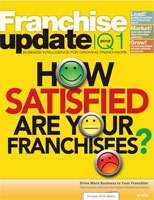Getting to First Base: "Moneyball" Provides Insight On Customer Loyalty
I recommend you get your management team together and take them to see the baseball movie "Moneyball," adapted from the book by Michael Lewis. You buy the popcorn and I promise you that "Moneyball" will deliver some powerful lessons about winning, and sustaining, customer loyalty.
If you're wondering what a movie about baseball has to do with customer loyalty, I can give you the answer in one word: insight.
The movie tells the story of how the Oakland Athletics first applied statistical analysis to winning major league baseball games. They built a predictive model where the key variable to winning was found to be getting on base. Lewis explained it like this: "... if you ran the analysis, you could see that the number of runs a team scored bore little relation to that team's batting average.
That "Aha" discovery--what those of us in the customer analytics business call insight--was a game-changer.
By having the guts to act on this insight, the A's general manager, Billy Beane (played by Brad Pitt in the movie), was able to win the same number of games with a $39 million payroll as the New York Yankees were able to win while spending $141 million.
Oakland spent so much less on payroll than New York by changing the way they selected players. From Oakland's perspective, the patience to draw a walk (get on base) should be as highly valued as the ability to hit a single. But that was "hidden" value because it doesn't show up in hitting percentage. As a rule, the higher the hitting percentage, the higher salary a player commanded. That was the tradition in the business of baseball. Everyone--except Oakland--was missing the truth: that hitting percentage did not correlate to winning games nearly as much as on-base percentage. So Oakland did not just pay less for their players, they also got more for their money!
You can compete effectively with larger and richer competitors by changing the way the game is played. In Los Angeles, Kogi Korean BBQ-To-Go provides a great example. (By the way, you will not find Korean tacos in Korea. Kogi is credited with inventing them in the US.)
Kogi is famous both for their Korean tacos and for their use of food trucks instead of traditional restaurant buildings. One reason they draw crowds is because they have a unique and wonderful product. Their chef is a guy named Roy Choi who was valedictorian of his class at the Culinary Institute of America and was named Amercia's best new chef in 2010.
Kogi's first "big break" came when it got the idea to contact Los Angeles food bloggers about trying their wonderful tacos. The bloggers loved Kogi and became powerful advocates. Through their voices, the Los Angeles community began to hear about, and want to try, Kogi's food.
To enable customers to find them--and isn't that a delicious twist on the traditional problem of finding customers--Kogi used Twitter to announce which locations its food trucks were visiting next. This led to considerable buzz on many of the social networking services and ultimately generated flash mobs showing up to meet the trucks. Newsweek recently proclaimed Kogi "America's first viral eatery."
There is a definitely a parallel here about challenging the ROI on traditional marketing versus unpaid marketing through social media. But it isn't that simple, because social media only works positively for brands that delight customers.
If your franchise is still tracking and reporting the combined total of Satisfied "4s" and Highly Satisfied "5s," you are missing out on the biggest insight in customer analytics in the past 25 years: only Highly Satisfied (i.e., delighted) customers are loyal. The winning strategy for building customer loyalty is to increase the number of delighted customers--that is the percentage of "5s" on a 5-point scale. That metric, Top Box scores, is the one that matters. Think of percentage of Top Box scores as on-base percentage for franchise organizations trying to create raving fans for the brand.
For more information about how to shape your customer experience to create highly satisfied and loyal customers, request the free white paper "Driving Performance with Top Box Scores" at www.smg.com/research.
Jack Mackey is vice president of Service Management Group (SMG), a leading customer experience analytics agency that improves performance for franchise and multi-unit firms. You can reach him at [email protected].
Share this Feature
Recommended Reading:
FRANCHISE TOPICS
- Multi-Unit Franchising
- Get Started in Franchising
- Franchise Growth
- Franchise Operations
- Open New Units
- Franchise Leadership
- Franchise Marketing
- Technology
- Franchise Law
- Franchise Awards
- Franchise Rankings
- Franchise Trends
- Franchise Development
- Featured Franchise Stories
FEATURED IN

Franchise Update Magazine: Issue 1, 2012








 The franchise listed above are not related to or endorsed by Franchise Update or Franchise Update Media Group. We are not engaged in, supporting, or endorsing any specific franchise, business opportunity, company or individual. No statement in this site is to be construed as a recommendation. We encourage prospective franchise buyers to perform extensive due diligence when considering a franchise opportunity.
The franchise listed above are not related to or endorsed by Franchise Update or Franchise Update Media Group. We are not engaged in, supporting, or endorsing any specific franchise, business opportunity, company or individual. No statement in this site is to be construed as a recommendation. We encourage prospective franchise buyers to perform extensive due diligence when considering a franchise opportunity.